Saturday, August 19, 2006
AUGUST 5th THROUGH AUGUST 12th FOUR MAJOR CITIES
Sunday August 6th and Monday August 7th – Berlin
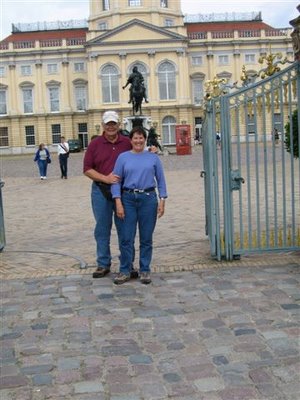
On Saturday we drove from Tignes to Bourg St Maurice and took a train from there to Paris. We were to connect with a night train with sleeping accommodations and go to Berlin. We had to change stations to get the Berlin train out of Paris. We went to the taxi line and it was so long that we were afraid that we would not make our connection if we used a taxi, so we went to the Metro which is the underground. We got lost trying to use the underground and missed our train. Night trains don’t travel as fast as the express high speed trains so they have to switch off and let the fast trains pass. We were able to get a fast train to Brussels and pass our night train on the way. We joined the night train in Brussels and used our reserved beds on the way to Berlin. We arrived in Berlin about 8:30 on Sunday morning.
We had reservations at a Hostel. I had never stayed in a hostel and was not sure what to expect. They are somewhere between a hotel and a bed and breakfast. They are bare bone necessity, but the one in Berlin was clean, neat, quite and secure. It also cost about one fourth what a regular hotel would cost in Berlin. They have like dorm rooms for four or eight people all sharing the same room and bath. These are real cheap. We were not quite sure we could handle the community bedrooms so we took a private room with our own bath. It was quite comfortable, and we found out when we checked in that we got breakfast included in the room charge. Breakfast in Europe is an amazing experience. You get cereal, fruit, yogurt, juice, coffee or tea, boiled eggs which they call cooked eggs, and sometimes scrambled eggs which they call scrambled eggs. To go with this you get several kinds of bread which always includes croissants, plus the butter, jams and preserves. Some places even give you chocolate and honey for the croissants. All in all it is a pretty hardy way to start the day.
I kinda got sidetracked there. The reason we went to our Hostel at 8:30 in the morning was to store our luggage. They allowed us to store our luggage Sunday, spend the night Sunday night, checkout on Monday morning and store our luggage on Monday while we were sight seeing. They had inexpensive internet access which we used Sunday evening and again Monday evening when we returned for our luggage. I was impressed with the service and with the building security. The building was open 24 hours, but the halls were locked and you had to use your room key to get into the hall. You even had to use your room key to get the elevator to take an up command. Going down you did not need a key. We are staying in Hostels in Brussels and in Paris so we will have a little more to compare to. So far we are pleased with the experience.
After we were all squared away with our luggage, we went out and learned to use the Metro without getting lost. We bought a two day pass ticket which allowed us to ride and get off and on as many times as we wanted to. It is an efficient system if you can figure out which line your need to be on. Mary is sure that our Sons would be very proud of us for navigating the network. When they were young we just followed them and the never got us lost. It was kinda like programming the VCR. When they were both gone and not there to do it for us we learned how. We rode the Metro to the train station and went to the Tourist Info Center to get hooked up with a good city tour. We took a tour with about 15 stops where you can get off and back on to the next bus coming by. It is a good way to become familiar with the city and pick points of interest which you want to go back to for more time. The only time we got off was to eat lunch. The next day, Monday, we went back to some of the more interesting places and to some other places we read about but did not visit on Sunday. We had a great two days except for the rain showers. We had about gotten used to the rain though, because it rained the last three days we were in Tignes I’ll try to high-light our two days in Berlin.
We started our tour from the central train station. I’ m going to try to combine my notes from Sunday and Monday and I hope I can summarize what we saw and keep it short enough that you will enjoy reading it. We certainly enjoyed seeing it. We had some key points of interest, but we passed many interesting things which were either addressed briefly or not at all. One of the these things was a national prison which still exists, and was used as housing for many of the East German military and political leaders when the communist regime crumbled.
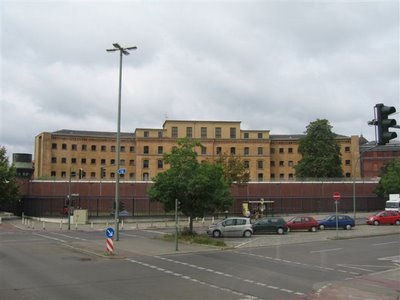
We passed a very elaborate Victory Spire which honors the victories over Austria, Denmark and one other country in three different wars.
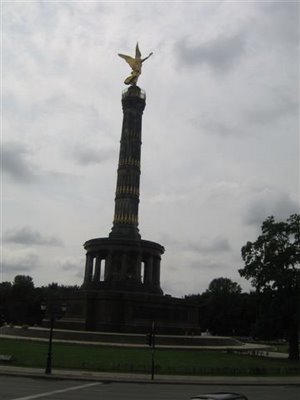
There are many such war memorials in the city. The German nation honors its war heroes. There is also a lot of pride in the academic achievement and institutions. The first private University in Berlin is Humbolt. The land and many of the buildings were donated by one of the princes. It is still in some of the original buildings. I think that these numbers are right, but the library there has six million titles and the number is increasing by about seventy five thousand per year. The University borders the campus of Berlin Technical University.

Just down the street from the educational center is a daily flea market which spreads along the street for several blocks.
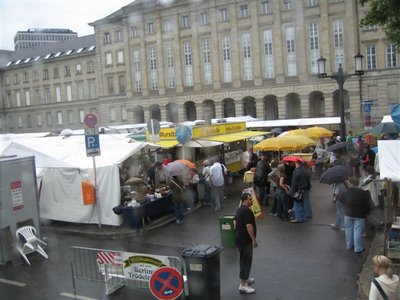
The origin of the market only goes back to the end of WWII. It started as a distribution center for the supplies from the air lift. The market grew from that.
We progressed into the section of the city known as Charlottenburg. This area was a separate city under the rule of Prussian kings. It did not become a part of Berlin until the early 1940’s. We saw a wonderful old Palace of the first Prussian King and Queen, Fredrick I and Sophie Charlotte.
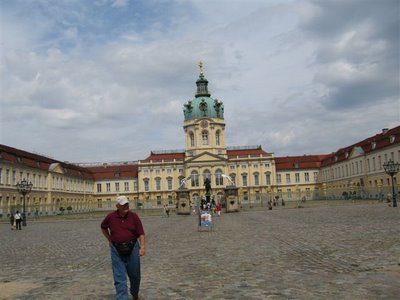
Fredrick I was called the Great Elector. The Palace was built from 1695 and finished in 1713. In 1740 an addition was added by the next Fredrick. There is a big Monument to Fredrick I in front of the Palace.
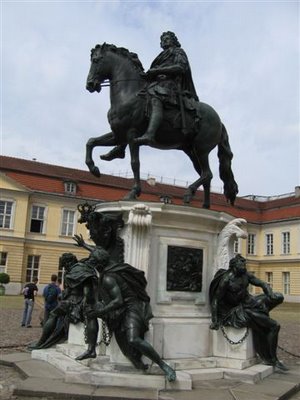
It was moved there in 1950 from its original site on the Long Bridge, now City Hall Bridge. The Monument dates from 1697. Directly acorss the street are two identical buildings which served as barracks for the royal guard. The buildings are now Museums of Art and Music and the Palace is now used for public meetings and especially concerts.

We traveled down one of the longest boulevards in Europe. It was named Kurfurstendamm Blvd. In the 1880’s when Otto Von Bismarck returned to Berlin after serving as the Ambassador France he brought back his love for the Champs Elysees. He wanted to model Kurfurstendamm after the famous Blvd in Paris. He mandated that all the buildings would be built up to four floors and would be stucco with each corner stone having a domed roof. It grew to be the center for shops, restaurants and theater in the turn of the century Berlin. I’m not sure how many buildings lined the blvd, but after WWII the bombs had destroyed all but 48 of the buildings along the 3.6 Km Boulevard.
On Sunday, Mary and I had lunch across the street from the Kaiser Wilhelm Memorial Church.
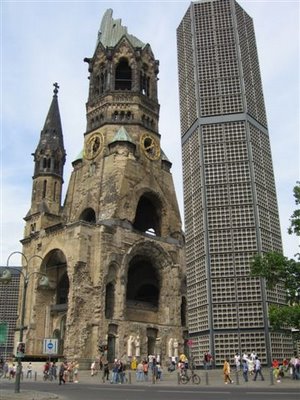
The Church was almost totally destroyed by bombs. It has been rebuilt in an ultra modern architectural style, but the old stone Church face is still standing with it’s bell tower as a memorial to the destruction of the war.
Berlin was founded in 1237. Today it covers 8875 square kilometers and has a population of 3.4 million people. There is a monument which is a big black metal curved cube. I think the guide on our tour said it was a 140 degree circle. It was presented to Berlin by France in honor of their 750th year anniversary. A lot of the city is old. A lot of the city is new because the old was destroyed during WWII. Hotel Berlin was rebuilt in 1958 and signaled the re birth of the traditions that had been such a strong part of the history of the city.

Berlin has more intercity park area than any other city in the world. One of the largest is the Tiegarten. Today it is a park with walking, biking and skating trails.
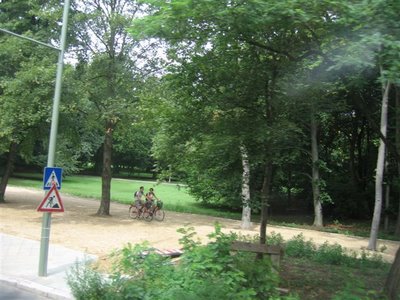
There are playgrounds, athletic fields, cafes and movie theaters in the park. The land was given to the city by the royal family. It had been a game preserve and the Royal Hunting Ground. On the streets surrounding the Teigarten are the building that house political parties, Embassies of many of the foreign countries and many of the public buildings like the library and most notable the world renowned Philharmonic
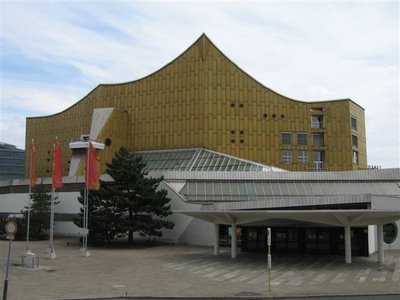
which is housed in two gold buildings at the end of the Embassy section. In the same area is the largest intercity park which came from the Konrad Adenauer trust.
The best example of the rebuilding of Berlin after the war is Potsdamer Platz.
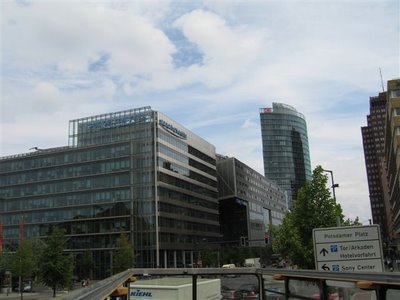
This area became the center for commerce and business in Berlin during the 1920’s. It was about 80% destroyed by Allied bombs. For the next 40 years or so it lay in ruins. Today it is again the center of commerce and the new center is built around the Sony Center and is big, pretty and almost totally glass.
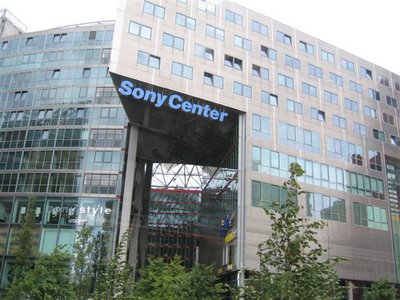
Mary observed that the Germans were a very optimistic people, and obliviously didn’t expect more bombing. The glass in Potsdamer would all come down very easily.
We saw the building which housed the Nazi Party Headquarters.
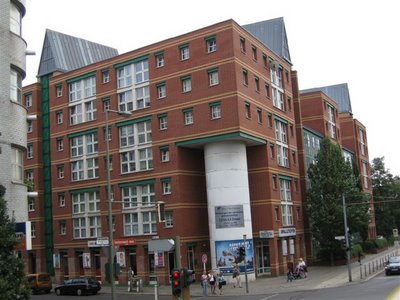
Near the building on the same street is a section of the Berlin Wall which has been preserved. It is defaced by graffiti and souvnier hunters, but you can still see the effect it would have on daily life.

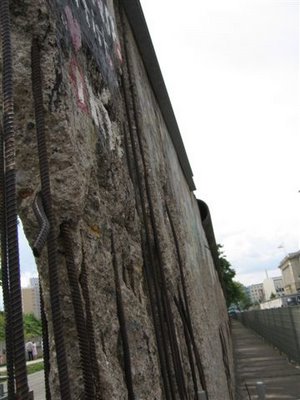
In the area behind the wall which had been the shooting zone and dog patrol area, there is an
open air display called Topography of Terror. It is a chronological record of the atrocities which the Nazis committed. It is obliviously there for the German People more than it is for tourists. About the first on third of the text and picture captions are in both German and English. The last two thirds there is only German language. We visited the wall and we went to Check Point Charlie and spent some time there.
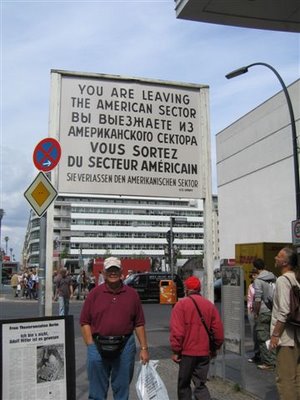
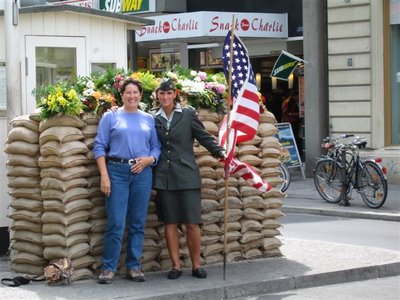
We got visa stamps for all the countries who were involved in the occupation of Berlin and the division of the city. Some significant statistics which stuck with me were that in the 1930’s there were 160,000 Jews living in Berlin. By 1945 there were very few. Today there are only about 14,000. There is a museum to the Jewish contribution to the heritage of Berlin and Germany and their contribution. There is a section of the museum which is dedicated to the Holocaust. It is a tower and it is empty.
We saved some of the prettiest of the old buildings until last. Near the Berlin Cathedral was a square which had the Berlin Concert House in the center with the German Cathedral on one side and the French Cathedral which was built for the Huguenots when they split from France.
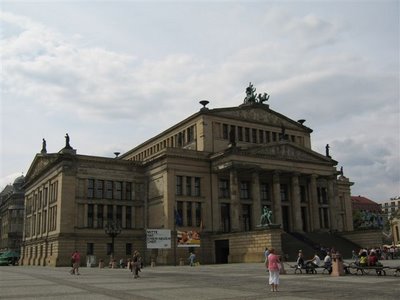
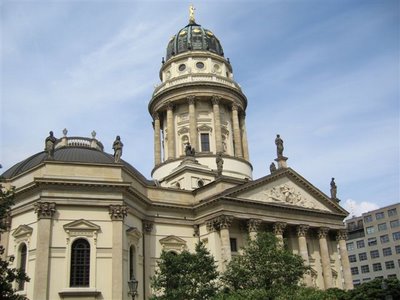
These buildings are among the most beautiful in the city.
From there we went to the seat of government. The Reichstag has been completely rebuilt and is identical to the original.
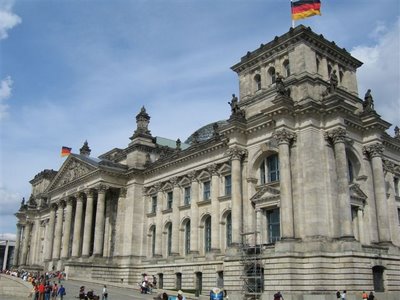
It is once again being used by parliament. I think just within the last couple of years. The Brandenburg Gate is the entry to the Government center.
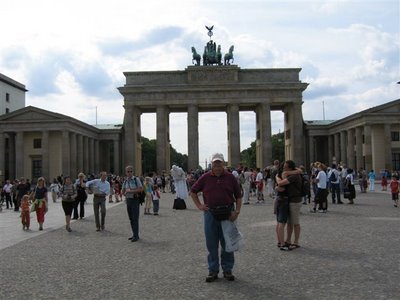
There is a very large plaza leading up to the Gate which is a meeting place for a lot of street entertainers. There are musicians, artists, mimes and panhandlers all competing for the tourist’s attention.
All in all I think that Berlin is the most interesting city which we have visited so far. I could have spent a lot more than two days here.
Sunday August 6th and Monday August 7th – Berlin

On Saturday we drove from Tignes to Bourg St Maurice and took a train from there to Paris. We were to connect with a night train with sleeping accommodations and go to Berlin. We had to change stations to get the Berlin train out of Paris. We went to the taxi line and it was so long that we were afraid that we would not make our connection if we used a taxi, so we went to the Metro which is the underground. We got lost trying to use the underground and missed our train. Night trains don’t travel as fast as the express high speed trains so they have to switch off and let the fast trains pass. We were able to get a fast train to Brussels and pass our night train on the way. We joined the night train in Brussels and used our reserved beds on the way to Berlin. We arrived in Berlin about 8:30 on Sunday morning.
We had reservations at a Hostel. I had never stayed in a hostel and was not sure what to expect. They are somewhere between a hotel and a bed and breakfast. They are bare bone necessity, but the one in Berlin was clean, neat, quite and secure. It also cost about one fourth what a regular hotel would cost in Berlin. They have like dorm rooms for four or eight people all sharing the same room and bath. These are real cheap. We were not quite sure we could handle the community bedrooms so we took a private room with our own bath. It was quite comfortable, and we found out when we checked in that we got breakfast included in the room charge. Breakfast in Europe is an amazing experience. You get cereal, fruit, yogurt, juice, coffee or tea, boiled eggs which they call cooked eggs, and sometimes scrambled eggs which they call scrambled eggs. To go with this you get several kinds of bread which always includes croissants, plus the butter, jams and preserves. Some places even give you chocolate and honey for the croissants. All in all it is a pretty hardy way to start the day.
I kinda got sidetracked there. The reason we went to our Hostel at 8:30 in the morning was to store our luggage. They allowed us to store our luggage Sunday, spend the night Sunday night, checkout on Monday morning and store our luggage on Monday while we were sight seeing. They had inexpensive internet access which we used Sunday evening and again Monday evening when we returned for our luggage. I was impressed with the service and with the building security. The building was open 24 hours, but the halls were locked and you had to use your room key to get into the hall. You even had to use your room key to get the elevator to take an up command. Going down you did not need a key. We are staying in Hostels in Brussels and in Paris so we will have a little more to compare to. So far we are pleased with the experience.
After we were all squared away with our luggage, we went out and learned to use the Metro without getting lost. We bought a two day pass ticket which allowed us to ride and get off and on as many times as we wanted to. It is an efficient system if you can figure out which line your need to be on. Mary is sure that our Sons would be very proud of us for navigating the network. When they were young we just followed them and the never got us lost. It was kinda like programming the VCR. When they were both gone and not there to do it for us we learned how. We rode the Metro to the train station and went to the Tourist Info Center to get hooked up with a good city tour. We took a tour with about 15 stops where you can get off and back on to the next bus coming by. It is a good way to become familiar with the city and pick points of interest which you want to go back to for more time. The only time we got off was to eat lunch. The next day, Monday, we went back to some of the more interesting places and to some other places we read about but did not visit on Sunday. We had a great two days except for the rain showers. We had about gotten used to the rain though, because it rained the last three days we were in Tignes I’ll try to high-light our two days in Berlin.
We started our tour from the central train station. I’ m going to try to combine my notes from Sunday and Monday and I hope I can summarize what we saw and keep it short enough that you will enjoy reading it. We certainly enjoyed seeing it. We had some key points of interest, but we passed many interesting things which were either addressed briefly or not at all. One of the these things was a national prison which still exists, and was used as housing for many of the East German military and political leaders when the communist regime crumbled.

We passed a very elaborate Victory Spire which honors the victories over Austria, Denmark and one other country in three different wars.

There are many such war memorials in the city. The German nation honors its war heroes. There is also a lot of pride in the academic achievement and institutions. The first private University in Berlin is Humbolt. The land and many of the buildings were donated by one of the princes. It is still in some of the original buildings. I think that these numbers are right, but the library there has six million titles and the number is increasing by about seventy five thousand per year. The University borders the campus of Berlin Technical University.

Just down the street from the educational center is a daily flea market which spreads along the street for several blocks.

The origin of the market only goes back to the end of WWII. It started as a distribution center for the supplies from the air lift. The market grew from that.
We progressed into the section of the city known as Charlottenburg. This area was a separate city under the rule of Prussian kings. It did not become a part of Berlin until the early 1940’s. We saw a wonderful old Palace of the first Prussian King and Queen, Fredrick I and Sophie Charlotte.

Fredrick I was called the Great Elector. The Palace was built from 1695 and finished in 1713. In 1740 an addition was added by the next Fredrick. There is a big Monument to Fredrick I in front of the Palace.

It was moved there in 1950 from its original site on the Long Bridge, now City Hall Bridge. The Monument dates from 1697. Directly acorss the street are two identical buildings which served as barracks for the royal guard. The buildings are now Museums of Art and Music and the Palace is now used for public meetings and especially concerts.

We traveled down one of the longest boulevards in Europe. It was named Kurfurstendamm Blvd. In the 1880’s when Otto Von Bismarck returned to Berlin after serving as the Ambassador France he brought back his love for the Champs Elysees. He wanted to model Kurfurstendamm after the famous Blvd in Paris. He mandated that all the buildings would be built up to four floors and would be stucco with each corner stone having a domed roof. It grew to be the center for shops, restaurants and theater in the turn of the century Berlin. I’m not sure how many buildings lined the blvd, but after WWII the bombs had destroyed all but 48 of the buildings along the 3.6 Km Boulevard.
On Sunday, Mary and I had lunch across the street from the Kaiser Wilhelm Memorial Church.

The Church was almost totally destroyed by bombs. It has been rebuilt in an ultra modern architectural style, but the old stone Church face is still standing with it’s bell tower as a memorial to the destruction of the war.
Berlin was founded in 1237. Today it covers 8875 square kilometers and has a population of 3.4 million people. There is a monument which is a big black metal curved cube. I think the guide on our tour said it was a 140 degree circle. It was presented to Berlin by France in honor of their 750th year anniversary. A lot of the city is old. A lot of the city is new because the old was destroyed during WWII. Hotel Berlin was rebuilt in 1958 and signaled the re birth of the traditions that had been such a strong part of the history of the city.

Berlin has more intercity park area than any other city in the world. One of the largest is the Tiegarten. Today it is a park with walking, biking and skating trails.

There are playgrounds, athletic fields, cafes and movie theaters in the park. The land was given to the city by the royal family. It had been a game preserve and the Royal Hunting Ground. On the streets surrounding the Teigarten are the building that house political parties, Embassies of many of the foreign countries and many of the public buildings like the library and most notable the world renowned Philharmonic

which is housed in two gold buildings at the end of the Embassy section. In the same area is the largest intercity park which came from the Konrad Adenauer trust.
The best example of the rebuilding of Berlin after the war is Potsdamer Platz.

This area became the center for commerce and business in Berlin during the 1920’s. It was about 80% destroyed by Allied bombs. For the next 40 years or so it lay in ruins. Today it is again the center of commerce and the new center is built around the Sony Center and is big, pretty and almost totally glass.

Mary observed that the Germans were a very optimistic people, and obliviously didn’t expect more bombing. The glass in Potsdamer would all come down very easily.
We saw the building which housed the Nazi Party Headquarters.

Near the building on the same street is a section of the Berlin Wall which has been preserved. It is defaced by graffiti and souvnier hunters, but you can still see the effect it would have on daily life.


In the area behind the wall which had been the shooting zone and dog patrol area, there is an
open air display called Topography of Terror. It is a chronological record of the atrocities which the Nazis committed. It is obliviously there for the German People more than it is for tourists. About the first on third of the text and picture captions are in both German and English. The last two thirds there is only German language. We visited the wall and we went to Check Point Charlie and spent some time there.


We got visa stamps for all the countries who were involved in the occupation of Berlin and the division of the city. Some significant statistics which stuck with me were that in the 1930’s there were 160,000 Jews living in Berlin. By 1945 there were very few. Today there are only about 14,000. There is a museum to the Jewish contribution to the heritage of Berlin and Germany and their contribution. There is a section of the museum which is dedicated to the Holocaust. It is a tower and it is empty.
We saved some of the prettiest of the old buildings until last. Near the Berlin Cathedral was a square which had the Berlin Concert House in the center with the German Cathedral on one side and the French Cathedral which was built for the Huguenots when they split from France.


These buildings are among the most beautiful in the city.
From there we went to the seat of government. The Reichstag has been completely rebuilt and is identical to the original.

It is once again being used by parliament. I think just within the last couple of years. The Brandenburg Gate is the entry to the Government center.

There is a very large plaza leading up to the Gate which is a meeting place for a lot of street entertainers. There are musicians, artists, mimes and panhandlers all competing for the tourist’s attention.
All in all I think that Berlin is the most interesting city which we have visited so far. I could have spent a lot more than two days here.